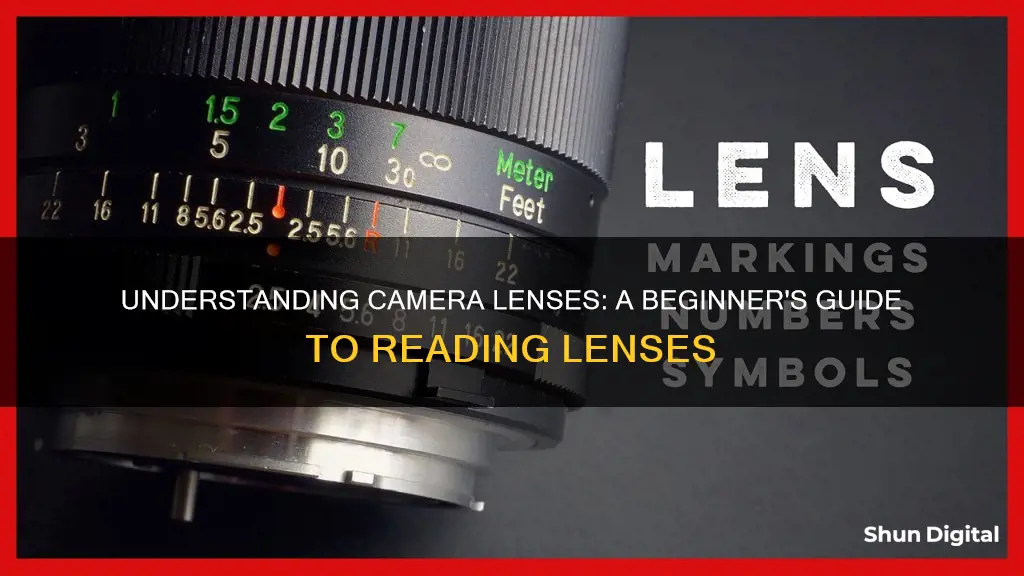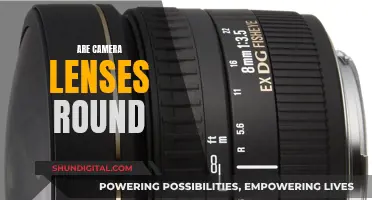
Camera lenses are stamped with a series of letters and numbers that can seem confusing at first glance, but they are essential to understanding the lens's capabilities and compatibility with your camera. In this guide, we will break down the most common markings found on camera lenses and explain what they mean, so you can make informed decisions about your photography equipment. From focal length and aperture to lens mount and image stabilisation, we will explore the key aspects of camera lenses and how to read them like a pro.
| Characteristics | Values |
|---|---|
| F-Numbers | Relates to the "speed" of the lens. The size of the aperture is denoted by an "f" followed by a slash and then a number, e.g. f/4.5. A smaller f-stop number signifies a wider aperture and a larger number signifies a narrower aperture. |
| Lens Mount System | The letter "F" can refer to the lens mount system. For example, FE on a Sony lens identifies the mount system it's compatible with. |
| Focal Length | Shown in millimetres (mm) on the lens. The focal length tells you the lens's field of view. The smaller the number, the wider the field of view. |
| Lens Diameter | The symbol Ø followed by a number tells us the diameter of the lens in millimetres. |
| Focusing Distance | The minimum focusing distance for the lens may be given in meters and feet, e.g. 0.9m / 2.96ft. |
| Macro and Magnification Ratio | Macro lenses can take photos of small things or very fine details. A 1:1 magnification ratio means the reproduction on the sensor is the same size or larger than the real-life object. |
| Autofocus System | Abbreviations tell us what type of motor the lens has for autofocus, e.g. STM (Stepping Motor) or USM (Ultrasonic Motor). |
| Image Stabilization | Lenses with built-in image stabilization will have an acronym to denote this, e.g. IS (Image Stabilization), VR (Vibration Reduction), OSS (Optical SteadyShot). |
| Premium Lens Classifications | Letters may signify that the lens is from a premium line, e.g. L (Canon), G (Sony), S (Nikon). |
What You'll Learn

Focal length
The focal length of a lens determines its angle of view and magnification. A longer focal length results in a narrower angle of view and higher magnification, while a shorter focal length provides a wider angle of view and lower magnification. In other words, a higher focal length value (e.g., 500mm) indicates a more "zoomed-in" view, whereas a lower value (e.g., 20mm) indicates a more "zoomed-out" perspective.
Lenses are typically classified into five categories based on their focal lengths: ultra-wide, wide-angle, standard, telephoto, and super-telephoto. Ultra-wide lenses have focal lengths less than 24mm, offering extremely wide views but often with some distortion. Wide-angle lenses have focal lengths between 24mm and 35mm, capturing wide vistas while minimising distortion. Standard lenses have focal lengths ranging from 35mm to 70mm, providing a perspective similar to human vision and are versatile for various photography genres. Telephoto lenses, with focal lengths from 70mm to 300mm, are ideal for capturing distant subjects without physically moving closer, making them popular for wildlife and sports photography. Super-telephoto lenses have focal lengths exceeding 300mm and are often used when the photographer cannot get close to the subject, such as in sports or wildlife photography.
Understanding Camera Lenses: A Beginner's Guide to Photography
You may want to see also

Aperture
F-Stop Numbers
The F-stop number (or focal-stop number) is a reference to how open or closed the aperture is. The most common F-stop values are: f/1.4, f/2, f/2.8, f/4, f/5.6, f/8, f/11, f/16, and f/22. The maximum and minimum aperture number varies from lens to lens.
The depth of field is the proportion of the image that is reasonably sharp and in focus. The larger the aperture, the shallower the depth of field, meaning more areas of the image will be out of focus. Conversely, a smaller aperture will result in a greater depth of field.
Using extreme aperture values is not recommended as it can result in a loss of sharpness. When you use a very large aperture, your lens cannot physically produce the sharpest results as the diaphragm will be wide open. Similarly, when you set a small aperture, an optical effect called diffraction occurs, resulting in poorer quality throughout the image.
Calculating the Sharpest Aperture
There is no rule of thumb to determine the sharpest aperture as it varies depending on the lens model. However, the sharpest aperture is always close to the lens "sweet spot", which is the aperture or F-stop value that produces the highest quality in terms of sharpness. To roughly calculate this sweet spot, move two to three F-stop values from the maximum aperture of your lens. For example, if the maximum aperture on your lens is f/4, the sweet spot will be between f/8 and f/11.
Exploring the Diverse World of Camera Lenses
You may want to see also

Lens mount
A lens mount is the interface between a camera body and a lens. It is a feature of camera systems that allows for interchangeable lenses. In other words, it is the part of the camera that the lens attaches to.
Different camera manufacturers (e.g. Sony, Nikon, Canon) tend to have their own proprietary lens mounts, which are often incompatible with other brands. Canon, for example, has four different types of lens mount: RF, RF-S, EF, EF-S, and EF-M.
Cameras and Lenses: Capturing the 3D World
You may want to see also

Lens diameter
The lens diameter is the physical measurement of the diameter of the front-most part of the lens. It is different from focal length and aperture. The diameter is often marked on the lens using the symbol "ø" followed by a number (e.g., ø52 for 52mm). This measurement is important when buying filters, lens caps, or hoods.
There is no set standard for lens diameter size, but there are some common sizes for the diameter of DSLR lenses: 43mm, 49mm, 52mm, 44mm, 58mm, 62mm, 68mm, 72mm, and 77mm. The right size filter is needed for the lens, and sometimes an adapter is required if the filter is not the correct size.
If the lens diameter is not marked on the lens, it can be measured with a ruler or calipers. The distance across the widest part of the lens should be measured, starting from the inside rim of the threaded area on one side to the inside rim of the thread on the other side. Common diameters used in DSLR lenses include 37mm, 39mm, 40mm, 40.5mm, 43mm, 46mm, 49mm, 52mm, 55mm, 58mm, 60mm, 62mm, 67mm, 72mm, 77mm, 82mm, 86mm, and 95mm.
The larger the lens diameter, the more light that can enter, and the larger the lens elements that can be used internally. This can potentially contribute to better optical quality, with less light fall-off at the edges (vignetting) and potentially sharper images at wide apertures. However, there are many other aspects that contribute to a lens's quality, including its optical design, the type and quality of the glass, and the manufacturing precision.
Cleaning Camera Lenses: Removing Scratches, Restoring Clarity
You may want to see also

Focusing distance
The minimum focusing distance is usually indicated on the lens in meters and feet. For example, a camera lens that shows 0.9m/2.96ft has a minimum focus distance of 0.9 meters or 2.96 feet. This means you can focus on anything closer than that distance.
On a zoom lens, the focusing distance may be a range of numbers. A reading of 0.5m/1.64ft-0.8m/2.63ft means that as the lens zooms in, the minimum focusing distance increases. At the widest focal length, the focusing distance is 0.5 meters. When zoomed in, the focusing distance is 0.8 meters.
The working distance is the distance from the front element of the lens to the subject. The effective working distance is the distance from the outer edge of the lens to the subject. This is important when the front element of the lens sits behind the outer edge, as is the case with many macro lenses.
The working distance can be calculated using the formula: WD = MFD - mfgLL - FFD, where WD is the working distance, MFD is the minimum focus distance, mfgLL is the manufacturer-specified lens length, and FFD is the flange focal distance (the distance from the sensor to the rear of the lens mount).
The working distance is particularly important in macro photography, where physical obstructions and frightening the subject can be a problem.
Pentax Lenses: Compatibility with Pentax Cameras
You may want to see also
Frequently asked questions
Millimetres, or "mm" for short, is the standard unit of measurement for the focal length of a lens. The lower the focal length (smaller number), the more you will see in your image (wider view). The higher the focal length (larger number), the less you will see in your image (more zoomed in).
This represents the lens's maximum aperture or how wide the opening on your lens is when you take a photo. The smaller the number, the wider the opening (which lets in more light).
This switch will allow you to change your lens from autofocus to manual focus.
The symbol Ø is the diameter symbol. This number refers to the diameter of your lens, which is important to know when purchasing lens filters and lens hoods.







